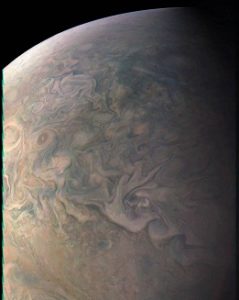
Last week, NASA’s Juno spacecraft successfully completed its fourth flyby of Jupiter and later sent some new stunning pictures of white oval storms and cyclone swirls on the planet.
The new image clearly shows the cyclone swirls around the south polar region of Jupiter, and white oval storms near the edge of the planet.
Juno’s JunoCam captured these new images on February 2, 2017 at 5:52 am PST while flying about 47,600 miles above Jupiter.
NASA gave the new image an interesting caption: “Cyclones swirl around the south pole, and white oval storms can be seen near the limb — the apparent edge of the planet — in this image of Jupiter’s south polar region taken by the JunoCam imager aboard NASA’s Juno spacecraft.”
Before Juno commenced its flyby, NASA invited the public to vote for the favorite spots on Jupiter that they would like JunoCam to capture.
Later NASA revealed that an individual has named the point of interest captured as “Jovian Antarctica” (in reference to Earth’s Antarctica).
According to NASA, Juno is currently taking 53 days to complete one orbit around the planet (compared to planned 14 day orbit) due to engine and software problem. The space agency says it is working to sort out the problem.
NASA stated: “Juno is currently in a 53-day orbit period around Jupiter as the team evaluates options for performing a maneuver to get the spacecraft into a shorter orbit period. While the initial plan was for the mission was to have 14-day orbits during this time, Juno can reveal amazing details about Jupiter even if it stays in the longer orbits for the duration of the mission.”
Jupiter is the largest planet in our solar system and appears to astronomers as a deep red orb surrounded by layers of orange, pale yellow, and white. Jupiter’s Great Red Spot is actually a massive, spinning storm – more than twice Earth’s size – in the atmosphere of the planet. The maximum speed of winds inside the storm sometimes reaches about 270 miles per hour.
Juno is a NASA space probe launched from Cape Canaveral on August 5, 2011, with an aim to study planet Jupiter. Juno was built by Lockheed Martin as part of NASA’s New Frontiers program to study Jupiter’s composition, magnetic field, gravity field, and polar magnetosphere. It is operated by NASA’s Jet Propulsion Laboratory. Juno entered a polar orbit of Jupiter on July 5, 2016. The mission life of Juno is 20 months, and during this period, Juno will try to find clues about the formation of Jupiter, the amount of water present within the deep atmosphere, mass distribution, its core composition, and its deep winds. After completion of the mission, the spacecraft will be deorbited into Jupiter’s atmosphere.
Juno is the second spacecraft, after Galileo, to orbit Jupiter. The nuclear powered Galileo spacecraft orbited around Jupiter from 1995 to 2003. Juno uses its solar arrays to get power to operate. Juno has three largest solar array wings ever deployed on a planetary probe, which generate power for Juno and also help in stabilize it.
